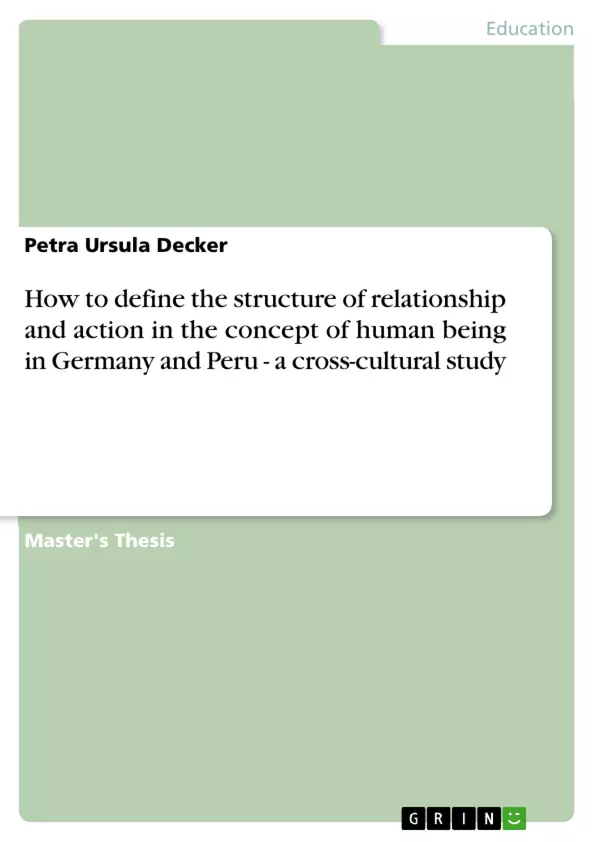This work is part of an investigation about the concept of human nature (Oerter et al., 1996). The investigation started in 1996 in West and East Germany as well as in Peru. A further investigation took place in 1998. The interviewed persons were between 18 and 25 years old. The researchers were Prof. Rolf Oerter and his co-workers in Germany and Peru (Oerter et al., 1999). The aim was to compare the concept of human nature in Germany and Peru. For my investigation, I analyzed parts of these interviews, which were done in 1996 with West and East German people as well as with campesinos/as, living in the Andes of Peru. I choose this topic, because for me it is very interesting to compare two different cultures with a different background, to find out, if there will be any common ground. The research questions are:
Are the levels of the structures about the concept of human nature universal? And:
Explain the substructures, which I developed, an increasing complexity about the concept of human nature?
The concept of human nature should be understood as a theoretical construction, which you can measure with a certain method, and this is an individual construction about a personal naive philosophy of human beings, which means to stimulate the implicit anthropology, an individual built up during his life span, where the background is defined by his meanings and actions. The five stages about the concept of human nature (Oerter, R., 1995), proved in former cross-cultural studies, which have already a theoretical background, will be explained later on and are fundamental for this work. Therefore, you need to know about the cognitive thinking of human beings, and how to measure this.
How to measure cognitive structures?
We consider the constructivistic approach for this investigation as an appropriate method. The investigation of the concept of human nature (Menschenbild) (Oerter, R. 1989) includes at the same time pre- and post-constructive activity of the researcher and interviewer, who introduce their knowledge, opinions and theoretical concepts. The results are general levels of the concept of human nature, some specific structures produced by the subjects, includes analytical categories, patterns, and figures of reasoning.
Table of Contents
- Introduction
- I. Theoretical models to explain development
- 1. Piaget's theory
- 2. Kohlberg's theory of moral development and his dilemma stories
- 3. The 'Zone of proximal development' (ZPD)
- 4. The structured approach by Oerter, including the five stages
- 5. Theoretical explanation to the interview
- 6. Culture and the self
- 6.1 Integrative model of universal stages and culture-specific patterns by Oerter
- 6.2 The self- an independent view ('western view') by Markus & Kitayama (1991)
- II. Method
- 1. Hypotheses
- 2. Adulthood interview and the dilemma stories
- 3. Procedure
- 4. Sample
- III. Results
- 1. Transformation of interview data about the 'ideal person' into relational structures
- 1.1 Characteristic structures for ‘ideal person’
- 1.2 Fig. 2 Substructures of the five characteristic structures of 'ideal person' in Germany 1996
- 1.3 Summary of 'ideal person'
- 2. Responsibility: Transformation of the interview data into action structures
- 2.1 Characteristic structures for responsibility
- 2.2 Fig. 4 Substructures of the three characteristic structures of responsibility
- 2.3 Explanation for the graphics used to express Responsibility
- 3. Structure and statements from the campesinos/as for responsibility in 1996
- 3.1 Explanation for Fig. 5
- 3.2 Explanation for Fig. 6
- 3.3 Structures and statements from the campesinos/as for 'ideal person' in 1996, Fig. 7
- 1. Transformation of interview data about the 'ideal person' into relational structures
- IV. Summary and Conclusion
Objectives and Key Themes
This master's thesis aims to define the structure of relationships and actions within the concept of human being, conducting a cross-cultural study between Germany and Peru. The study seeks to understand how cultural contexts influence the development of these structures, particularly examining the differences and similarities in perspectives between two distinct cultures.
- Cross-cultural comparison of relational and action structures.
- The influence of cultural context on individual development.
- Application of theoretical models to explain development in different cultural settings.
- Analysis of interview data to identify and compare characteristic structures.
- Exploration of the concept of the "ideal person" and the role of responsibility in different cultures.
Chapter Summaries
- Introduction: This chapter provides an overview of the master's thesis, outlining its objectives and research questions. It also presents the theoretical framework that will be used to analyze the data.
- I. Theoretical models to explain development: This section explores various theoretical models, such as Piaget's theory, Kohlberg's theory of moral development, the Zone of Proximal Development (ZPD), and Oerter's structured approach. It examines how these models contribute to understanding individual development and their application across cultures.
- II. Method: This chapter details the research methodology used in the study. It covers the hypotheses, interview methods, data collection procedures, and the characteristics of the sample.
- III. Results: This section presents the findings of the cross-cultural study. It analyzes the interview data to reveal the characteristic structures of relationships and actions related to the "ideal person" and responsibility, comparing results between Germany and Peru.
Keywords
The primary keywords and focus topics of this thesis include cross-cultural comparison, relational structures, action structures, ideal person, responsibility, cultural context, development, theoretical models, interview analysis, Germany, Peru, and qualitative research.
- Quote paper
- Petra Ursula Decker (Author), 1999, How to define the structure of relationship and action in the concept of human being in Germany and Peru - a cross-cultural study, Munich, GRIN Verlag, https://www.grin.com/document/29660



